GURUTHUMA WEB
උගත මනා ශිල්පයමයි මතු රැකෙනා...!

Tuesday, May 31, 2016
- මාර්ටින් වික්රමසිංහ මහතා / martin wickramasinghe
43 comments:
It is good for our knowladge
Very important things...thnks to author
Very important information
wow excellent
Thank you 😊
Good to know know
Very informative.Thank you!!!
Very good essay
Very good a essay for childrens
It helps me a lot thank you sooo much
all the things they said in the chat
Thanks very much It is very useful for us . i took this as my eassy thx
useful interesting
Great👌 Thank you😊
Very interested essay for children. Thank you so much.
Very good essay thanks auther 🙏
Very good essay thank you so much👍🏻
Wow . this good
Wow . This good .
Super this is a very very good easy
this site give us knowledge. and good for children's. superb
Very useful
This is very useful.Thank you auther
thank you and well done..
Thank you very useful ☺️��☺️
Thank you. Yes This is a very useful pool/source to everyone. This is a need of the hour.
good kmmmmmmmmmmmmmmm
Thank You so much this is very useful
I can write a nice easay thank you
Post a Comment
අප සමග එකතු වෙන්න.
- ආදි කාලින ඓතිහාසික තොරතුරු
- දිස්ත්රීක්ක හා ප්රධාන නගර.
- දේශීය ගත්කතුවරු
- ලංකාවේ වන ජීවී තොරතුරු
- විජයාගමනයෙන් පසු ඓතිහාසික තොරතුරු.
- විදේශීය ගත්කතුවරු
- ශ්රී ලංකාවේ ආර්ථික තොරතුරු.
- ශ්රී ලංකාවේ කර්මාන්ත.
- ශ්රී ලංකාවේ ගමනාගමනය.
- ශ්රී ලංකාවේ ජාතිකත්වය
- ශ්රී ලංකාවේ දේශපාලන තොරතුරු
- ශ්රී ලංකාවේ පළාත්
- ශ්රී ලංකාවේ පිහිටීම
- ශ්රී ලංකාවේ ප්රධාන අපනයන බෝග
- ශ්රී ලංකාවේ වනාන්තර
- ශ්රී ලංකාවේ වැව් හා ජලාශ.
- ශ්රී ලංකාවේ විදුලි බලාගාර.
- ශ්රී ලංකාවේ විවිධ ආගම්
- ශ්රී ලංකාවේ ශ්රේෂ්ඨ චරිත
Blog Archive
- ► May (1)
- ► November (1)
- ► October (25)
- ► September (29)
- ► July (1)
- ► June (26)
- කුමාරතුංග මුනිදාස / kumaratunga munidasa
- ඩබ්ලිව්. ඒ සිල්වා / W.A Silva
- පියදාස සිරිසේන. / Piyadasa Sirisena
- ආනන්ද කුමාරස්වාමි / ananda coomaraswamy
- හතරවෙනි පණ්ඩිත පරාක්රමබාහු රජු.
- දෙවැනි පණ්ඩිත පරාක්රමබාහු රජු.
- සේන සලමෙවන් රජු. / King Sena Salamewan
- අලගියවන්න මුකවැටි. / Alagiyawenna Mukaveti
- වැලිවිට සරණංකර සංඝරාජ හිමි. / weliwita saranankara...
- විල්ගම්මුල මාහිමි. Wlgammula Mahimi
- පතිරාජ පිරුවන් හිමි
- ධර්මසේන හිමි.
- විද්යා චක්රවර්තී
- මයුරපාද හිමි. / Maurapada Himi
- ගුරුළුගෝමී පඬිතුමා. / gurulugomi Padituma
- වීදාගම මෛත්රී හිමි. / weedagama maithree thero
- ශ්රී ලංකාවේ ජාතිකත්වය. / Nationality of Sri Lanka.
- තොටගමුවේ ශ්රී රාහුල හිමි. / Thotagamuwe Sri Rahul...
- සංචාරක ව්යාපාරය. / Tourism.
- ලංකාවේ ධීවර කර්මාන්තය. / Sri Lankan fisheries indu...
- කෘෂි කර්මාන්තය. / Agriculture.
- ► April (15)
වැදගත් වෙබ් අඩවි
Sample text, social icons, sample text, featured posts.
Guruthuma Web
මේ අපේ font එක, popular posts.
- මහගම සේකර / Mahagama Sekara
- ටිබෙට් ඇස්. මහින්ද හිමි. / Tibet S.Mahinda Himi
- දයාසේන ගුණසිංහ / dayasena gunasinghe
- ආනන්ද රාජකරුණා / ananda rajakaruna
- ශ්රී චන්ද්රරත්න මානවසිංහ. Sri Chandrarathna Manawasinghe
- ගුණදාස අමරසේකර / gunadasa amarasekara
- රබීන්ද්රනාත් තාගෝර් / rabindranath tagore
- ජී.බී සේනානායක / G.B Senanayake
වෙලාව
Copyright 2009 - GURUTHUMA WEB All Rights Reserved. Powered by Blogger Blogger Templates created by Deluxe Templates | WordPress theme by 9th sphere
The Modern Novel
The world-wide literary novel from early 20th century onwards, martin wickramasinghe.
Home » Sri Lanka » Martin Wickramasinghe
Martin Wickramasinghe was born in Koggala, in the South of Sri Lanka, in 1890. He studied Sinhalese as a young child but later learned English, in which he became fluent. When his father died when he was eleven he returned to the Sinhalese school. He left school aged sixteen and worked as a book-keeper. After his mother’s death, he took up writing, publishing his first novel in his early twenties. He subsequently worked as a journalist and later became a newspaper editor. His best-known novel, ගම්පෙරළිය (The Uprooted) Part 1: (The Village) was published in 1944 and is considered the first serious Sri Lankan novel. He continued to write, published literary criticism, novels and poetry. He travelled extensively, visiting the United Kingdom, India, China, Cuba and the Soviet Union. He died in 1976.
Other links
His official website Martin Wickramasinghe Martin Wickramasinghe Martin Wickramasinghe Martin Wickramasinghe Martin Wickramasinghe Folk Museum, Koggala
Bibliography
[Only books translated into/written in English]
1940 අපේ ගම (Lay Bare the Roots) 1944 ගම්පෙරළිය (The Uprooted) Part 1: (The Village) 1947 මඩොල් දූව (Madol Doova) 1950 Sinhalese Literature 1951 The Mysticism of Lawrence 1952 Aspects of Sinhalese Culture 1956 The Buddhist: Jataka Stories and the Russian Novel 1956 විරාගය (The Way of the Lotus Viragaya) 1963 Landmarks of Sinhalese Literature 1964 Buddhism and Culture 1970 Selected Short Stories 1971 Revolution and Evolution 1972 Buddhism and Art 1975 Sinhala Language and Culture
Privacy Overview

- Books & Theatre

15 Top Languages Spoken in India

Sucha Mela 2024 returns to Willenhall to Celebrate Punjabi Culture

7 Top Bangladeshi Poets You Need to Know

Ram Murali talks ‘Death in the Air’ & Murder Mystery

Alia Bhatt launches Children’s Book
- Business & Employment
- UK & World

Indian Man details Ordeal of ‘Forced’ Sex Change Operation

London Man drives 18,300km to India to Visit Mother

‘Show-Off’ Drug Dealer busted after Sharing Pics of Luxury Flat

Vijay Mallya hosts Lavish Wedding for Son Siddharth

US Indian Astronaut stranded in Space

Feroze Khan seeks Prayers for his Sick Father

Arsalan Naseer claims ‘Nepo Baby’ stole his Project

Fiza Ali breaks silence on Marriage Rumours

Sehar Khan’s Teenage Romance role in ‘Jafaa’ Sparks Debate
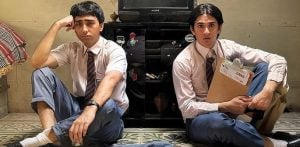
‘Na Baligh Afraad’ opens to Mixed Reviews
- Style & Glamour

Top 20 Most Stylish Male Indian Celebrities

Janhvi Kapoor exudes Mermaid Vibes at Paris Haute Couture Week

Shazeal Shoukat’s Sheer Outfit sparks Backlash

Hamza Sohail’s Daring Photoshoot sparks Criticism

How to Nail the ‘Buttermilk Yellow’ Fashion Trend
- Food & Drink

10 Indian Celebrity Chefs to Follow on Instagram

Lidl Chicken ‘contaminated with Superbugs’

5 South Asian Restaurants Loved by Hollywood Celebrities

Healthy Alternative Flours for Your Rotis & Chapatis

5 Delicious Indian Carrot Dishes to Make
- Health & Fitness
- Beauty & Grooming
- Relationships & Sex

How Do I Get Out of a Situationship?

How Can I Talk to My Partner About STI Testing?

10 Skincare Products Loved by Pakistani Actresses

How Do I Define My Relationship Status?

Laila Zuberi discusses Saba Faisal & Bushra Ansari’s Cosmetic Work

Mai Dhai features on Times Square Billboard


10 Best Dance Performances in Indian Award Shows

Attaullah Esakhelvi shares details about his Five Marriages

Why did Diljit Dosanjh offer ‘Lover’ to Karan Johar for Free?

10 Top Bollywood Music Videos featuring Sexual Scenes
- South Asian

Is England’s Lack of Pressing down to Tiredness?

Babar Azam issues Defamation Notice to Mubasher Lucman

Mubasher Lucman accuses Pakistani Cricket Team of Match-Fixing

Is Sania Mirza marrying Mohammed Shami?
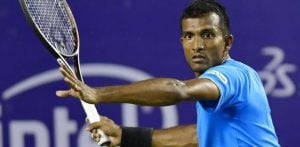
How Sriram Balaji went from Journeyman to 2024 Olympics

India’s Complicated Relationship with Condoms

10 Social Stigmas that Still Exist in Sri Lanka

7 Indian Transgender Trailblazers who Broke Barriers

British South Asian Prisoner Families: The Silent Victims?

10 Bollywood Celebrities who faced Mental Health Issues
- Technology & Gaming

How You can Get a Bargain Holiday

Apoorva Mukhija: From Social Media Influencer to Actress

Meet Zara Shatavari, India’s Entry for Miss AI

FlexiSpot E7: A Masterpiece of Design and Functionality

The Rise of Indie Games developed by Indians
- About DESIblitz
- DESIblitz Team
- Privacy Policy
- Advertise with Us
Filter your search
- Arts & Culture
- Competitions
- Film & TV
- Health & Beauty
- Music & Dance
1-12 of 20 Results
Arts & Culture > Culture
Martin wickramasinghe ~ writer of culture and life.
Martin Wickramasinghe is a celebrated writer of Sinhala literature. DESIblitz explores the magnificent work of this Sri Lankan novelist.
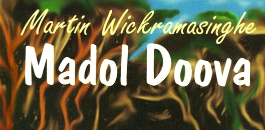
By Shameela Yoosuf Ali

Many of his works have been made into films and soap operas
Martin Wickramasinghe is a legend of Sinhala literature. The man travelled a long way through his writing to explore the roots of Sri Lankan life.
Wickramasinghe was born in 1890, in the town of Koggala, in Southern Sri Lanka.
Koggala is a scenic location surrounded by the sea, and Wickramasinghe spent a carefree childhood there, which later influenced his writings.
He learned the Sinhala language at his village temple from a Buddhist monk and later studied in a village school for some time.
In 1897, he was sent to an English school in Galle called Buena Vista, where Wickramasinghe excelled in English and Latin.
Martin Wickramasinghe began his literary career in 1914 with his debut novel Leela and a collection of essays on literary criticism Shastriya Lekhana in 1918.
But his ground-breaking novel with serious intent, titled, Gamperaliya was published in the year 1944.
Wickramasinghe played many roles in Sri Lankan’s literary arena. As a constructive philosopher, an inspiring thinker and a great novelist who divulged the story of his era and its people.
Many of his works have been made into films and soap operas.
Wickramasinghe’s oeuvres don’t carry the contents of popular literature, but Sri Lankan mainstream media have been celebrating his works.
Related Reads
- Priya Kumar ~ Motivational Writer and Speaker
- Leela Soma ~ Scotland's Asian Writer
- Writer Nasir Adeeb talks ‘The Legend of Maula Jatt’
As a result he has been able to acquire a unique place in the realm of Sinhala literature even today.
Wickramasinghe was one of the pioneers of the genre of poetry called Nisandas, which broke the conventional rules placed on poetry.
He was inspired by the works of Eliot, Pound, and Whitman.
Gamperaliya – The Uprooted (1944)
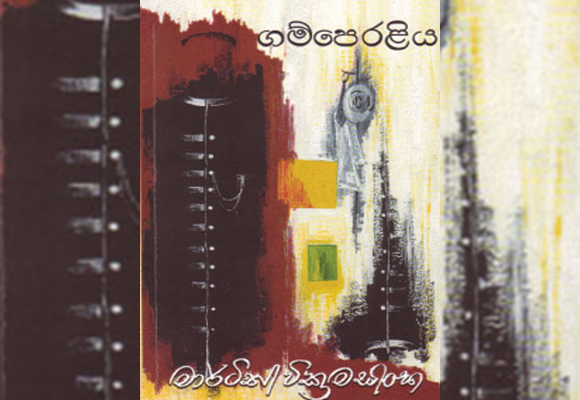
The most illustrious novel of Wickramasinghe’s popular trilogy is Gamperaliya . The novel gives a picture of the collapsing of a traditional village life by the bulldozers of modernisation.
Based on a feudalistic family of the village, this novel articulates the story of three generations.
The way that historical politics functions on rural feudalistic families, and the thriving of a new middle-class society, is drastically described in Gamperaliya .
Piyal, a face of this new social class, gradually attacks this feudalistic society. He is a handsome English teacher, who falls in love with Nanda, a high-class family girl.
Their relationship plays the transitional situation of the class struggle in ancient Sri Lanka.
This realistic novel portrays the breakup of village life and the penetration of modernisation.
Gamperaliya was adapted to a film by renowned director Lester James Peries.
The film was internationally applauded, receiving many awards including the Golden Peacock at the International Film Festival of India and the Golden Head of Palenque in Mexico.
It was also commended in the 3rd Moscow International Film Festival. Cannes Film Festival showcased it in May 2008 under the French title, Changement au Village.
Rohini (1937)
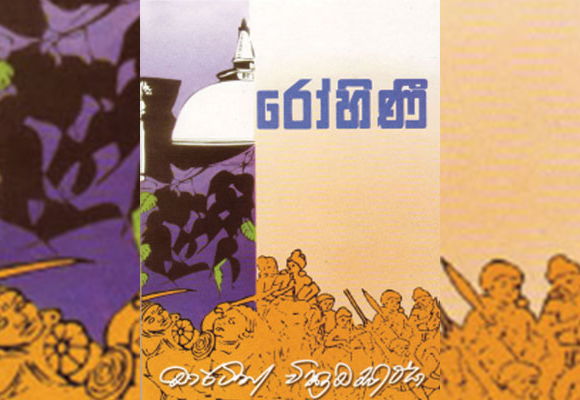
A tale of romance set in the locale of the Dutugemunu era represents a legendary affair between Athula and Rohini.
Athula, a war hero from the Army of King Dutugemunu, falls in love with the young princess Rohini, whose father is a minister of King Elara.
Princess Rohini is also proposed to by her father’s diplomatic friend, Mithra.
In this novel, Wickramasinghe tends to emphasise the critical political issues hidden behind the romantic story.
Many anthropologists and historians find it interesting for its historical references and it is also considered to be one of the timeless classics of Sinhala literature.
Madol Duwa – Mangrove Island (1947)
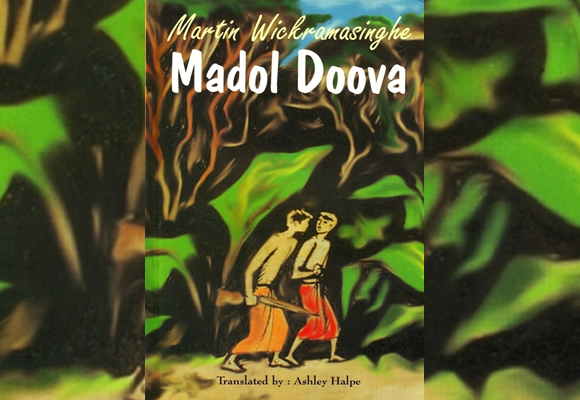
The famous young adult novel of Martin Wickramasinghe has been included in the literature curriculum of Sri Lankan schools.
The story takes place in the 1890s and portrays the lifestyles and culture of that pre modern era.
It is an adventure story of Upali Giniwelle, and his servant friend, Jinna.
The main characters in this novel, they are notorious youngsters who explore their lives by outrunning their parents.
Wickramasinghe sarcastically portrays the failure of adults in understanding the world of children.
Upali and Jinna find an isolated small island called Madol Doova, situated in the middle of Koggala tank.
They cultivate this land and gradually become businesspersons.
The story of these two youngsters has been created by Wickramasinghe as an adventure which delights the reader till the end.
Madol Doova has been translated into more than 9 languages including English and it was made into a film in 1976 by Lester James Peries.
Yuganthaya – End of the Era (1949)
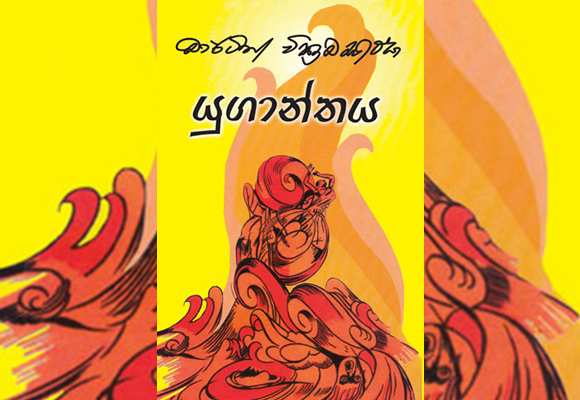
The last novel of his trilogy, tells the story of the collapse of feudally rooted Sri Lankan upper middle-class society and the emergence of new English-speaking capitalistic upper-class society.
Simon Kabilana is an influential cold-blooded capitalist who abuses his workers and generate high production shares.
In comparison, his son Malin, has been educated in England. And venerating Marx and Lenin, he possesses opposing views.
Malin eventually gives up his fortunes and confronts his father’s suppression.
Challenging the long dominance of old feudalism, this novel brings out numerous social disputes.
The novel ends with the emergence of modern political tradition which encloses English speaking urban crowd and foreign educated capitalistic people who proclaim themselves as socialists.
Yuganthaya explains the new wave of Sri Lankan political and social interests based on their political ideology using the characters Malin Kabalana and Aravinda Wiharahena.
The book is an artistic depiction of Sri Lankan political history and its rapid changes. It was adapted to many stage plays and got attention for its intertextuality.
Ape Gama – My Village (1940)
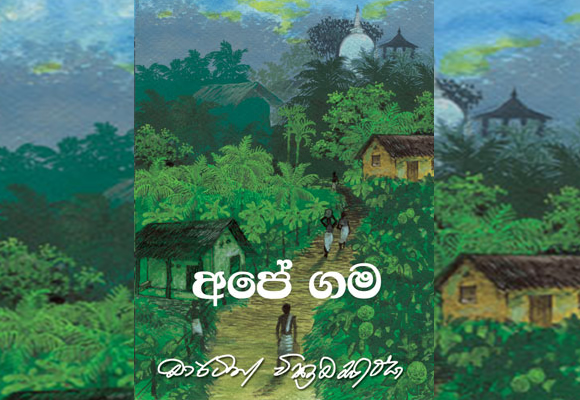
The realistic and soulful portrayal of typical rural life, Ape Gama is one of best novels written by Martin Wickramasinghe.
When reading this book, one can feel the depth and details of life in the rural community as he vividly describes every single experience of his village life.
Even though it is considered a children’s novel, it entertains adult readers as well.
Anyone can enjoy this book because we all share that nostalgia for our past, especially if one is coming from a village.
This novel takes us on a journey back to our childhood and reminds us the beauty of our own past.
Martin Wickramasinghe was awarded an honorary Ph.D. by the University of Ceylon in 1970.
His literary contribution and his writings brought an identity to Sri Lankan literature.
Wickramasinghe is celebrated by both readers of serious literature and admirers of popular literature, because of his portrayal of the reality of Sri Lankan life.
His writings aren’t just fictions but are historical references of Sri Lanka’s past and its culture.

Shameela Yoosuf Ali
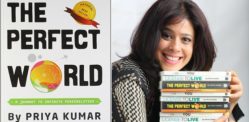
What's New
Share article, "quoted".
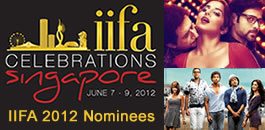
Nominees for IIFA 2012 Awards
Should Bollywood writers and composers get more royalties?
View Results
- Polls Archive

To provide the best experiences, we and our partners use technologies like cookies to store and/or access device information. Consenting to these technologies will allow us and our partners to process personal data such as browsing behavior or unique IDs on this site and show (non-) personalized ads. Not consenting or withdrawing consent, may adversely affect certain features and functions.
Click below to consent to the above or make granular choices. Your choices will be applied to this site only. You can change your settings at any time, including withdrawing your consent, by using the toggles on the Cookie Policy, or by clicking on the manage consent button at the bottom of the screen.
| --> | ||||||||||||||||||||||||||||||||||||||||||||||||||||||||||||||||||||
| | © 2003-2018 martinwickramasinghe.org All Rights Reserved. Academia.edu no longer supports Internet Explorer. To browse Academia.edu and the wider internet faster and more securely, please take a few seconds to upgrade your browser . Enter the email address you signed up with and we'll email you a reset link.
 The Aesthetic through and beyond Capital: Speculations on Martin Wickramasinghe's Gamperaliya and Viragaya 2019, Postcolonial Text This article addresses the question of how one may historicize aesthetic change, especially in the context of the third-world novel, by conceiving the aesthetic as a historically contingent category that mediates between the singularity of form and the particularity of content. This question is supplemented by a discussion of the aesthetic modes of two Sinhala novels: Martin Wickramasinghe’s Gamperaḷiya (1944) and Virāgaya (1956). The method of historicizing that is proposed involves two interpretative levels that follow the contours of Dipesh Chakrabarty’s categories of History 1, or history posited by capital, and History 2, or histories outside the life processes of capital. While History 1 enables a totalizing interpretation which allows Gamperaḷiya and Virāgaya to be thought of as embodying a narrative/realist aesthetic and affective/modernist aesthetic respectively, History 2 enables a close scrutiny of specific aspects of aesthetic mediation and play which complicate History 1’s totalizing and often Eurocentric thrust. Related PapersRajendran Chettiarthodi Transcending psychological inhibitions caused by colonial encounter in the comprehension of the past is a daunting task in aesthetic discourses, given the fact that colonial paradigms are difficult to erase and contemporary public spaces of art like Museums, as argued by Edward Said are colonial projects. India's perceptions related to the creation, nature, and evaluation of arts has gone a sea change in the colonial period which created a sort of alienation towards the manifestation of indigenous culture among the colonial subjects. Apart from this, the nature of performance, display, patronage venue, audience and space all underwent far reaching transformations in the process. Leela Gandhi demonstrates that in its reflexive modality, post colonialism holds out the possibility of thinking our way through and out of the historical imbalances and cultural imbalances produced by the colonial encounter.1However, in the retrieval of traditional discourses, distortions are bound to happen when using modern terminology , especially as Aesthetics itself happens to be a non indigenous discipline. Despite these severe methodological constraints, the present paper proposes to explore the relationship between the aesthetic theory formulated by thinkers like Abhinavagupta and praxis related to the creation, experience and evaluation of art forms like the performance arts , painting and sculpture in Precolonial India. The paper will focus on the extant and limitations of the inter relatedness with a view to bring to the fore the tensions involved and the insights they could yield in contemporary attempt to make sense of theory and praxis.Apart from the theoretical works, the sources which are being consulted would comprise self reflexive statements of multi faceted artists like Kalidasa who have occasion to deal with art in its various manifestation in the representation of life. It is hoped that such an exercise will be of some use in the comprehension of tradition and for some sort of self reflexivity in contemporary times especially in addressing issues of identity of Indian art. Needless to say, the paper distances itself from any type of exhortations to 'return to the past' as the present writer feels that tradition in its most creative phase is always dynamic and experimental. Tradition is only one of the resources for the creative spirit.. It is indeed a daunting task to locate the conventional precolonial discourse which could be the exact counterpart of modern aesthetics which would discuss problems related to theory and praxis. Natyasastra , the seminal and iconic text of performing arts of India is virtually an encyclopedia of Indian arts in which the center piece is dramatic performance, but which incidentally discusses allied arts like music and dance. In one way, it is the edifice on which the entire aesthetic thought of India is built. Texts like 1 1 Leela Gandhi, Post Colonial Theory, p.176. Arthur Dudney Published in A Sense of Place: Essays in Post-Colonial Literature, ed. Britta Olinder, Gothenburg: Gothenburg University, 1984: 142-50.s John Thieme Katherine Butler Schofield How do we write histories of the ephemeral: of affective and sensory experience, of devotional states and journeys, of the live performance of music and dance—of the tangible yet transient texture of the experiential moment? More critically, how do we write such histories when the moment has long passed into silence? Can emotion, devotion and the arts tell us critical things about the harder-edged worlds of political, economic and social history that we couldn't otherwise access? What is the relationship between the aesthetic, the affective, the ethical and the political in South Asian history? These are some of the questions these three important volumes of essays raise and begin to answer. I say begin, because all three are pioneering, and while they open wide the gates onto ill-explored country, there are many miles left to tread before we will be able to see even the extent of the terrain spread out before us. Jagath Weerasinghe positions: east asia cultures critique Jenson Joseph For the earliest attempts in Malayalam cinema seeking to evolve a poetic aesthetic, the paradoxical relation toward urban modernity that emerged among the middle class by the middle of the twentieth century—defined by antagonism as well as fascination—operated as the axis around which new spectatorial relations could be maneuvered. This article takes up for discussion two Malayalam films from the mid-1950s—Newspaper Boy (dir. P. Ramadas, 1955) and Rarichan enna powran (Citizen Rarichan, dir. P. Bhaskaran, 1956)—as cinematic experiments in conceiving the urban space from two influential ideological positions, and as attempts in adapting to modernist idioms of international cinema. Modalities of imagining the urban space, the author argues, attained crucial historical significance in aesthetics and politics: it enabled the cultural producers to aesthetically situate the films within global cultures of cinema, thus invoking and molding the contemplative viewer; politically, these films mark the earliest attempts to conceive the region's relation to modernity through the grids of imagining the urban. Sharad Deshpande Balirano, G. 2008. Indian Diasporic Aesthetics as a Form of Translation. In Ciocca, R. / Laudando, M. (eds), Indiascapes: Images and Words from Globalised India. Anglistica AION: An Interdisciplinary Journal 12(2) [Special Issue]: 87-96. Giuseppe Balirano Indian diasporic creativity, although exclusively produced in one “source” language, English, seems to rely on some techniques typically used in translation. Translation studies have indeed recognized that in every act of translation the source text is inevitably transformed. This form of transformation in postcolonial productions is mainly realised by the employment of specific linguistic devices with the aim of representingthe lives and adventures of diasporic characters who, rather than speaking English, are portrayed as dubbed or translated into English. Therefore, new questions are inevitably raised about the original and the adapted version, the source and the target, the text and the context, the content and form of Indian diasporic aesthetics. The paper focuses on some Desi creative features employed to de-colonize culture from both the Western ex-colonizers and the more ‘traditional’, national or even post-national cultures which deny the importance of hybrid productions by marginalizing them. A multimodal analysis of Jhumpa Lahiri’s The Namesake (2003) and its homonymous filmic translation by Mira Nair (2007), is aimed at decoding typical Desi media practices and discourse(s) as new forms of narration in diasporic representations. Loading Preview Sorry, preview is currently unavailable. You can download the paper by clicking the button above. RELATED PAPERSChamila Somirathna GLQ: GAY AND LESBIAN QUARTERLY Alpesh Kantilal Patel The Question of the Aesthetic Ankhi Mukherjee Dr. Mina Sanahmadi Annemari de Silva Sharae Deckard Literature and Aesthetics:The Journal of the Sydney Society of Literature and Aesthetics Savitha A.R , Sruthi S South Asian History and Culture (DOI: 10.1080/19472498.2015.1063219) Sourit Bhattacharya Orbis Litterarum Word Image Text: Studies in Literary and Visual Cultures Ed. Shormishtha Panja et al Dr. Sonali Pattnaik Saskia Fernando ed., Chandraguptha Thenuwara: Covert (Colombo: Saskia Fernando Gallery) Edwin Coomasaru The Bloomsbury Research Handbook of Indian Aesthetics and the Philosophy of Art Parul Dave-Mukherji University of Toronto Quarterly Anupama Mohan South Asian Review Ralph Nazareth Indian Theatre Journal Cynthia Ling Lee Daniele Cuneo Pratibha प्रतिभा Pavithra Tantrigoda Robin Jones Ram B H A W A N Yadav Humanities, Provocateur Rajarshi Dasgupta SMART M O V E S J O U R N A L IJELLH Johanna Hahn Comparative Literature Françoise Lionnet RELATED TOPICS
Lankapradeepa - Portal to Sri LankaMartin wickramasinghe.  Martin Wickramasinghe (Sinhala: මාර්ටින් වික්රමසිංහ; Tamil: மார்ட்டின் விக்கிரமசிங்க) (1890-1976) was a Sri Lankan novelist, short-story writer, critic, essayist and editor. He is considered a pioneer writer of modern Sinhala literature. Life EventsWickramasinghe was born on 29 May 1890 in Koggala to a family of the village headman class in the Southern Province (Abhayasundere & Wijayarathna, 2022). His formal education at his village school lasted less than 5 years and at the age of fourteen, he was forced to leave Koggala for Colombo and Batticaloa in search of employment (Abhayasundere & Wijayarathna, 2022). His professional life as a writer started in 1920 at the Lake House group of newspapers where he became an editor of the daily Dinamina and the Sunday Silumina (Gunawardena, 2003). Wickramasinghe's life as a novelist began with Leela in 1914 (Gunawardena, 2003). His trilogy of Gamperaliya (1944), Yuganthaya (1948) and Kali Yugaya (1957) depicted the impact of modernising influence on a southern coastal village (Gunawardena, 2003). The novel Viragaya which was regarded by many as the finest work of fiction in Sinhala was published in 1956 (Gunawardena, 2003). His work Gamperaliya was turned into a movie in 1963 by Lester James Pieris and it won several international awards including the Indian Golden Peacock Award for the best film in 1964. Wickramasinghe was not only a master of Sinhala and English but Sanskrit and Pali languages as well (Abhayasundere & Wijayarathna, 2022). He has written 96 books and a large number of articles and papers on the culture and civilization of the Sinhala people over a period of more than 50 years (Abhayasundere & Wijayarathna, 2022). A number of his works have been translated and published in English, Hindi, Tamil, Russian, Chinese, Romanian, Dutch, German, French and Japanese languages (Abhayasundere & Wijayarathna, 2022; Senanayake, 2016). PublicationsOf the Novels, the Madol Doova was translated into Russian (1954), Bulgarian (1961), Chinese (1961), Romanian (1962), English (1968), Dutch (1979), Tamil (1993 and Japanese (2002) languages and made into a film in 1976 (Gunawardena, 2003). The novel Viragaya was also translated into English ( The Way of the Lotus , 1985), Tamil (1992) and French (1995) and made into a film in 1987 (Gunawardena, 2003). Wickramasinghe's trilogy Gamperaliya , Kaliyugaya and Yuganthaya were published in the Russian language in 1975 while Gamperaliya was published in Tamil in 1964 (Gunawardena, 2003). The Gamperaliya , Kaliyugaya and Yuganthaya were made into films in 1963, 1981 and 1983 respectively (Gunawardena, 2003). Short story collectionsLiterary criticism, evolution and anthropology, autobiography, books in english. Besides the movies, Wickramasinghe's three novels and a few short stories have been made into television series (Gunawardena, 2003). Wickramasinghe was bestowed several honours and awards for his contribution to modern Sinhala literature.  Martin Wickramasinghe TrustThe Martin Wickramasinghe Trust was established in 1976 after the death of Wickramasinghe with the objectives of preservation of manuscripts, first editions of all books, tape recordings and photographs related to his life and work. Wickramasinghe's library which consisted of over 5,000 volumes in several languages was gifted to the government by the Trust and it is now available for reference in the Martin Wickramasinghe Hall of Literature at the National Library in Colombo (Gunawardena, 2003). Presently, Wickramasinghe's birthplace in Koggala is maintained as a Museum of Folk Culture by the Trust. 1) Abhayasundere, P.N. and Wijayarathna, W.K.M., 2022. Anthropological gleanings of the work of Martin Wickramasinghe. Vidyodaya Journal of Humanities and Social Sciences VJHSS (2021), Vol. 06 (02). pp.55-64 2) Gunawardena, C.A., 2003. Encyclopedia of Sri Lanka. Sterling Publishers Pvt Ltd. ISBN: 81-207-2536-0. pp.308-312. 3) Senanayake, C.J., 2016. Work and utopia in the fiction of Martin Wickramasinghe and James Goonewardene (Doctoral dissertation, Monash University). p.9. Post a CommentSearch form

Sunday, 10 Sep 2023
Martin Wickramasinghe, a nationalist sans prejudice - W.A. Abesinghe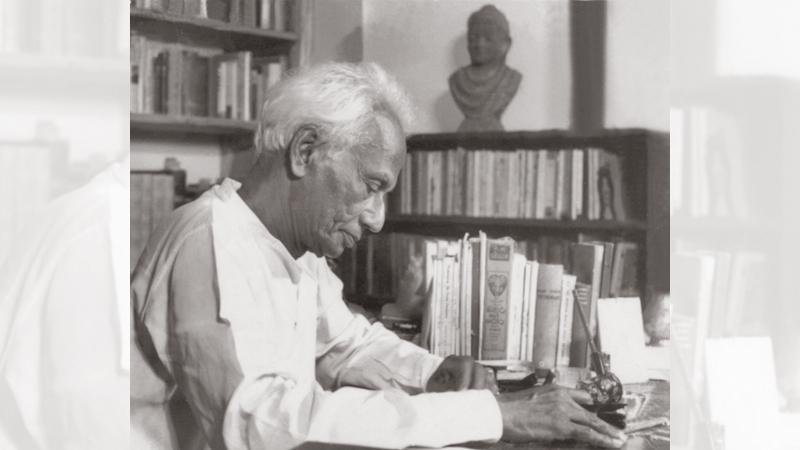 Sri Lanka's foremost writer Martin Wickramasinghe's 44th death anniversary falls on July 23. The Sunday Observer spoke to veteran writer and senior counsel, W.A. Abesinghe to discuss Martin Wickramasinghe's literary endeavour as well as his personal relationship with the author. Upon the death of Wickramsinghe, he has taken on the role of editing the late authors' archives and produced biographies and critical essays on the subject. Q. How did you meet Martin Wickramasinghe? A. It was in 1963. At that time, I was teaching at the Kuliyapitiya Central College. My friend Dissanayake who was also a teacher there and I started a school magazine called 'Pratibhana' (‘’). During that time, Wickramasinghe launched his book 'Soviet Deshaye Nageem' ('Resurrection of Soviet Union'). I wrote a review on the book to the 'Veemansa' magazine which was one of the main magazines in Sri Lanka. Wickramasinghe had read the review and sent me a copy of 'Soviet Deshaye Nageem' to our school, which was a great honour to me. I wrote a letter inviting him to write an article to our school magazine. He obliged and wrote an article titled 'Nawa Sahityaartha' to 'Pratibhana'.  Around this time, I quit my teaching profession and joined the 'Dinamina' (‘n™pñj’) at Lake House. There, I wrote a letter to him asking an appointment. He agreed, and we met at his home at Nawala, Kirimandala Road. Afterwards, we met often, even after I left Lake House. We were constantly exchanging correspondence at the time. I have secured over 30 letters by him. I wrote him in English, and he wrote back to me in English. His letters are long and intellectually rich. Q. How do you think about him? A. He was a great man. He didn't hesitate to give his books to anybody. After I resigned from Lake House, I worked as a teacher at a Pirivena in Delgoda. Even at the time, he used to send me copies of his newly published books through his driver. As a result, I have got a number of his autographed books. Q. Could you remember specific incidents between you and him? A. I remember one incident. I met Ven. Udakendawala Saranankara Thera, a stalwart in Communist movement in Sri Lanka. He was a central committee member of the party and edited its official newspaper, 'Nawa Lokaya' . Though I was not a member of the party, I worked with him, especially the 'Nawa Lokaya'. Then, I found that Ven. Udakendawala Saranankara Thera was a friend of Martin Wickramasinghe. Thereafter, I sometimes went to meet Wickramasinghe with Ven. Saranankara Thera. I joined the 'Attha' (‘R¥l‰l’) newspaper edited by B.A. Siriwardhane and received the membership of the Communist Party. When I worked there, I visited Wickramasinghe a number of times, especially to get interviews for the paper. Wickramasinghe had a close relationship with the Communist Party and the 'Attha' was close to him. In 1965, Ven' Saranankara Thera wanted to establish a writers' association in Sri Lanka. He convened writers and set up the 'Samastha Lanka Lekhaka Sanwidanaya' ’ - All Ceylon Writers' Association). Wickramasinghe was its president and K.M. Sirisena, a journalist at the Lakadeepa, was the Secretary. I was the Assistant Secretary. When the America - Vietnam war started, the Soviet Union opposed to America's military occupation in Vietnam. They began to rally around the writers to condemn the attack. They formed an association called Afro-Asian Writers' Association. The association held conferences and one was to be held at Bakur in Azerbaijan. They invited our association too for the conference. As the convener of the writers' association, Ven. Saranankara Thera discussed with Martin Wickramasinghe as to who would take part in the conference. Wickramasighe had suggested to Ven. Saranankara Thera to go with me to the conference. I took part in the conference with Ven. Saranankara Thera. I got this opportunity because of Wickramasinghe. It was my first foreign tour and Ven. Saranankara's last foreign tour, because the Thera passed away the following year. The All Ceylon Writers' Association received another Afro-Asian Association invitation. It was to be held in Beirut, Lebanon. Wickramasinghe was to decide as to who would attend the conference, and he told me, "You should go, but who is the other who should go with you?" I proposed K. Jayathilake. Though Wickramasinghe and Jayathilake were not in friendly terms at the time, he said, "Oh, yes. You go with him." Wickramasinghe did not cross any person forever. When I became the Features Editor of the 'Sirilaka' (‘’) newspaper, launched by Sirimavo Bandaranaike, I contacted Wickramasinghe when I needed a serious article. He was my main source. Q. Could you remember the time when 'Bhawa Tharanaya' (‘ ) novel came about? A. Yes. All the bhikkus came up against him at the time. Even Ven. Yakkaduwe Pragnarama Thera wrote three volumes and criticised him severely. We, as writers, defended him and wrote articles on the issue. Though all the people around him roared against him, he didn't panic. He was cool all the time and didn't take any attack seriously. Q. I heard that there was an interesting incident when Wickramasinghe participated in your wedding? A. It was 1972. There were no sufficient food and other items in shops. Though we organised the wedding, we didn't offer lunch with rice for visitors. We offered short meals with liquor. Wickramasinghe was not well at the time. He couldn't go to Kuliyapitiya where the wedding was held, straight away from Colombo. He was coming to the wedding with his wife, Prema Wickramasinghe. He came to Negombo the previous day and spent the night at a hotel there and attended the wedding the next day. I had invited K. Jayathilake and Gunasena Withana too, from Colombo. When they met at the wedding hall, Wickramasinghe invited them to have meals from the hotel he spent the previous night as they couldn't take lunch. On their way back to Colombo, they had their meals at the Negambo hotel. K. Jayathilake wrote about this incident in his autobiography, 'Punchi Pele Gasa Wena' (‘’). These tales attest to his greatness and kindness. He helped writers throughout his life. Q. You refered to the 1960s. It was the time that the Peradeniya School was most powerful. You may have personal experiences with him on the Peradeniya School? A. Wickramasinghe attacked the Peradeniya School. Though it was highlighted in his books, he didn't accept its ideologies. He wrote a book titled 'Japan Kama Katha Sevanella' (‘’) in condemning the Peradeniya School. I wrote an article on the book to the 'Poda Attha' (‘’). He liked it very much. The debate on the book went on, and we supported this. Q. How did you feel when he died in 1976? A. I felt it was a great loss for the country. He lived a well-planned, complete and full life. He engaged in most of the genres in literature. He wrote short stories, novels, trilogies, poetry, reviews and translations. He did all things a writer could do. He with his brilliant ideas was an enlightened man. He wrote progressive books. Q. How about his political ideas? A. Throughout his life, he remained a nationalist, but he hadn't racial prejudices. He admired the socialist movement and detested capitalism. He politely declined the Magsaysay award as it was an American award. There are 0 CommentsRelated articles. Produced by Lake House . Copyright © 1995 - 2023 The Associated Newspapers of Ceylon Ltd.
| |||||||||||||||||||||||||||||||||||||||||||||||||||||||||||||||||||



IMAGES
VIDEO
COMMENTS
Tuesday, May 31, 2016. මාර්ටින් වික්රමසිංහ මහතා / martin wickramasinghe. 1890 මැයි මස 29 වන දින මාර්ටින් වික්රමසිංහ මහතා උපත ලැබීය. කොග්ගල, මලලගම ළමා හේවගේ දොන් බස්තියන් වික්රමසිංහ මොහුගේ පියා වන අතර මාගොල්ලෙ බලපිටියේ ලියනගේ නොච්චිහාමි මව වූවාය. 1895 දී අන්දිරිස් ගුරුන්නාන්සේගෙන් අකුරු ඉගනීම මුලින්ම කළ අතර 1897 දී ගමේ පන්සලෙන් ඉගනුම ලැබුවේය.
Literary career. His literary career began with the novel Leela (1914) and an anthology of essays on literary criticism, Shastriya Lekhana (1919).
Martin Wickramasinghe was a great Sri Lankan writer of the 20th century. He was born is 1890 at Koggala, in the Southern Province, close to Galle. Martin Wickramasinghe published 14 novels and 104 short stories. His first novel was 'Leela' published in 1914.
His best-known novel, ගම්පෙරළිය (The Uprooted) Part 1: (The Village) was published in 1944 and is considered the first serious Sri Lankan novel. He continued to write, published literary criticism, novels and poetry. He travelled extensively, visiting the United Kingdom, India, China, Cuba and the Soviet Union. He died in 1976. Other links.
Essay on Martin Wickramasinghe with Sinhala Explanation.SUBSCRIBE AND JOIN WITH ME.....I'm a government school English and English Literature Teacher in a ...
Martin Wickramasinghe began his literary career in 1914 with his debut novel Leela and a collection of essays on literary criticism Shastriya Lekhana in 1918. But his ground-breaking novel with serious intent, titled, Gamperaliya was published in the year 1944.
Martin Wickramasinghe was one of the most prominent Sri Lankan writers of all times. He was born in 1890 in a village in Southern Sri Lanka, Koggala. It is said that the landscape of this place, where he had spent his childhood was what inspired most of his novels and stories.
Martin Wickramasinghe (1890-1976) was the most prolific Sinhala writer of the 20th century, having produced not only an unparalleled plethora of work ranging from fiction to philosophy, history and anthropology, but having been a watershed in the aesthetic trajectory of Sinhala novelistic writing.
Martin Wickramasinghe (Sinhala: මාර්ටින් වික්රමසිංහ; Tamil: மார்ட்டின் விக்கிரமசிங்க) (1890-1976) was a Sri Lankan novelist, short-story writer, critic, essayist and editor. He is considered a pioneer writer of modern Sinhala literature.
Martin Wickramasinghe's vision was primarily nurtured in the tolerant, humane, realistic attitude to life traditional to Buddhist folk culture. He valued the intellectual freedom and independence inspired by the Buddha's 'Kalama Sutta' which he saw as a tradition to question tradition, not unlike the Western scientific attitude.
The official website of Martin Wickramasinghe. One of the Sri Lanka's greatest authors and intellectuals. This website will provide all children and adults alike comprehensive access to the great heritage of literature he has left us.
Madol Doova (Sinhala: මඩොල් දූව is a children's novel and coming-of-age story written by Sri Lankan writer Martin Wickramasinghe and first published in 1947. The book recounts the misadventures of Upali Giniwella and his friends on the Southern coast of Sri Lanka during the 1890s.
GURUTHUMA WEB. උගත මනා ශිල්පයමයි මතු රැකෙනා...! Tuesday, May 31, 2016. මාර්ටින් වික්රමසිංහ
ගමේ සාම්ප්රදායික ආර්ථික හා සමාජ ව්යුහය වාණිජකරණය වූ නගරය විසින් ක්රමයෙන් ආදේශ කරනු ලැබීම නිරූපණය කිරීම සඳහා දකුණේ ගමක සාර්ථක ...
Sri Lanka's foremost writer Martin Wickramasinghe's 44th death anniversary falls on July 23. The Sunday Observer spoke to veteran writer and senior counsel, W.A. Abesinghe to discuss Martin Wickramasinghe's literary endeavour as well as his personal relationship with the author.
The official website of Martin Wickramasinghe. One of the Sri Lanka's greatest authors and intellectuals. This website will provide all children and adults alike comprehensive access to the great heritage of literature he has left us.
This thesis, "Re-visioning a Discipline: Martin Wickramasinghe's Contribution to Comparative Literature," explores the comparative approach of Martin Wickramasinghe, the pioneering twentieth-century Sri Lankan novelist, literary-cultural critic, and
Martin Wickramasinghe: He wrote for children too . Martin Wickramasinghe is one of the all-time great writers of Sri Lanka. He is hailed as the foremost writer in Sinhala in the 20th century. He wrote novels, short stories and essays on our cultural heritage, and a history of Sinhala literature.
One of the Sri Lanka's greatest authors and intellectuals. This website will provide all children and adults alike comprehensive access to the great heritage of literature he has left us.
SKU. martin-wickramasinghe-keti-katha-ekathuwa-2-sarasa. සිංහල බසින් පළ වු මුල්ම කෙටිකතා සංග්රහය මාර්ටින් වික්රමසිංහ විසින් රචිත ගැහැනියක්ය. එය ප්රකාශයට පත් වු 1924 අවුරුද්ද යථාර්ථවාදී සිංහල කෙටිකතාවේ ආරම්භක අවස්ථාවද විය.
1975 වසරේදී ඔහුගේ 85 වෙනි ජන්ම දිනයට සමගාමීව කොග්ගල මහා ප්රඥයා (Martin Wikramasinghe The Sage of Koggala ) ලෙසින් ලිපි එකතුවක් පල කර ඇති අතර එහි දෙස් විදෙස් ...
All of Martin Wickramasinghe's published writings in Sinhala and English, including first editions, translations of books published in 9 foreign languages as well as manuscripts are on display in the Hall of Life and Literature.